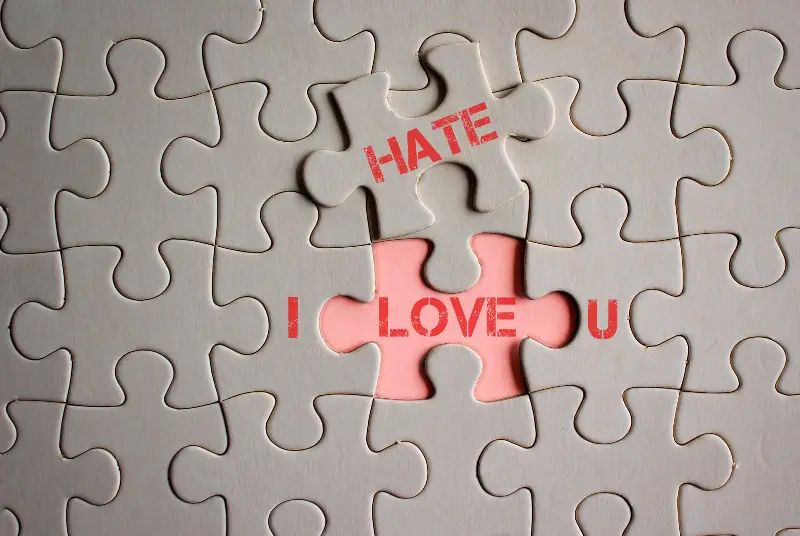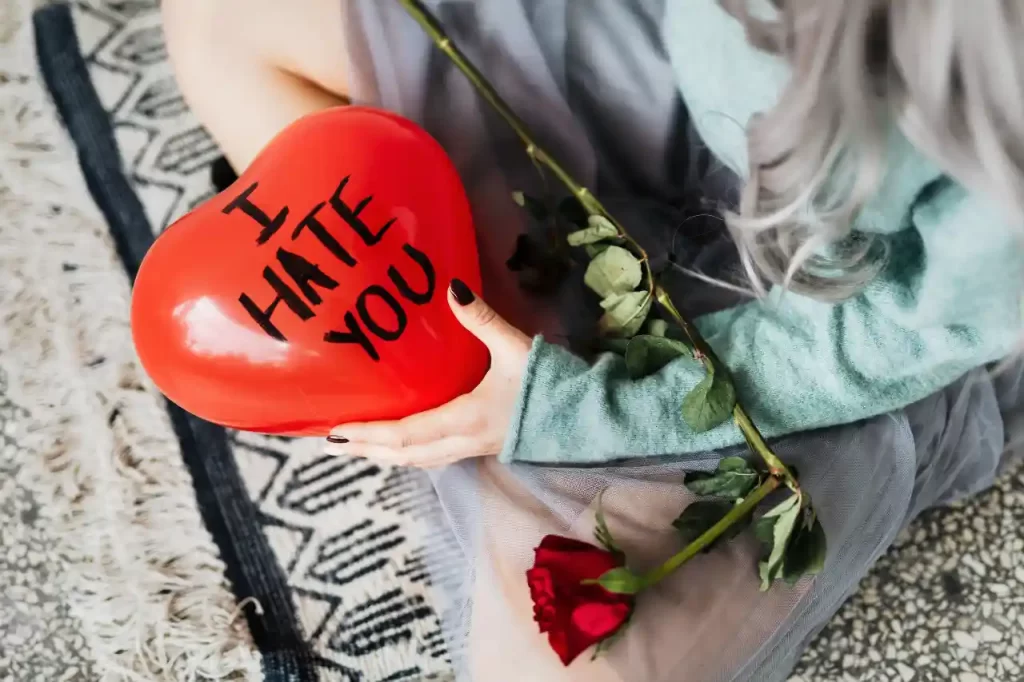Ah, the love-hate relationship. It’s an intriguing dance, isn’t it? One moment you’re laughing together, and the next, you can’t even be in the same room. You might have seen it in movies, but I assure you, it’s just as real in daily life. In my years of helping couples navigate these tumultuous waters, I’ve gleaned valuable insights that can make a difference.
You know, love-hate relationships aren’t always as chaotic as they seem. Sometimes, they reveal underlying passions and unmet expectations that need addressing. We’ll explore this and much more together. But before we dive into the secrets, let me share a perspective you might find surprising: these relationships can be navigated successfully, and I’m here to guide you through it.
So, are you ready to unravel the complexities of a love-hate relationship? In the following sections, we’ll explore its origins, the roller coaster of emotions involved, and, most importantly, effective strategies to transform it into something beautiful and lasting. Buckle up because this journey will take us to some unexpected places, and I promise, it’s one you won’t want to miss. Stay tuned!

What is a Love-Hate Relationship?
A love-hate relationship is one of those fascinating dynamics that seems almost paradoxical at first glance. That intriguing blend of affection and frustration, tenderness and irritation, can make a relationship both thrilling and exhausting. But what exactly constitutes a love-hate relationship, and why does it happen?
You see, a love-hate relationship isn’t about simple likes and dislikes. It’s about profound connections mixed with serious conflicts. Imagine feeling a deep love for someone yet being angered by their habits or viewpoints. It’s not the presence of love or hate alone but the intermingling of these emotions that defines this kind of relationship.
Some might think that a love-hate relationship is unhealthy or a sign of failure. But that’s a common misconception. This dynamic often stems from unspoken expectations, lack of communication, or differing values. It doesn’t necessarily mean doom and gloom. On the contrary, understanding and addressing the underlying issues can lead to a more profound connection.
But don’t mistake a love-hate relationship for a mere phase or a fleeting emotion. It can be a persistent pattern, and if not addressed, it can lead to a cycle of ups and downs that might wear both partners down. The key here is recognizing the pattern and taking steps to understand each other better.
Do you know what’s fascinating about love-hate relationships? They’re not exclusive to romantic connections. You might experience this dynamic with a friend, family member, or even a colleague. The roller-coaster of emotions can be both captivating and draining.
But here’s a teaser for you: Could a love-hate relationship actually be a blessing in disguise? What if I told you that its challenges could be a gateway to deeper understanding and intimacy? Intrigued? I bet you are. As we move forward, we’ll explore how this complex dynamic can be a catalyst for growth and transformation.
Stay with me, and you’ll discover that a love-hate relationship isn’t something to fear or avoid. The right guidance and willingness to face the challenges can become a rewarding journey towards a stronger and more loving connection. Let’s take this journey together, shall we?
What are the Signs of a Love-Hate Relationship?
Recognizing the signs of a love-hate relationship can be like unraveling a mystery. These signs aren’t always clear-cut, but they’re essential in understanding the dynamics at play. Let’s delve into these signs together and see if any resonate with your own experiences.
Intense Emotional Swings
In a love-hate relationship, emotions can swing from one extreme to another in the blink of an eye. One moment everything is perfect; the next, small issues become major problems. It’s the unpredictability of these swings that defines this sign.
Passionate Arguments
Arguments in a love-hate relationship are often intense and heated, fueled by both love and frustration. While disagreements are common in any relationship, they tend to be more frequent and emotionally charged here.
Deep Connection Followed by Distance
One hallmark sign of a love-hate relationship is the alternating pattern of deep connection followed by emotional distance. It’s like a dance where closeness is followed by withdrawal, reflecting the constant push and pull.
Focus on Negatives
While you deeply care for one another, the focus often shifts to the negatives. Small annoyances become magnified, leading to dissatisfaction, even when many positive aspects are present.
Lack of Communication
Ironically, communication can break down in a love-hate relationship despite the emotional intensity. Important feelings go unexpressed, and misunderstandings can grow, further complicating matters.

Jealousy and Possessiveness
These emotions may become pronounced, reflecting the insecurity and fear often accompanying a love-hate relationship. It’s a sign that trust may need to be rebuilt.
Feeling Misunderstood
A common feeling in this dynamic is that your partner doesn’t truly understand you. Despite deep connections, you might feel alone or misrepresented, causing frustration.
Idealizing and Devaluing
In a love-hate relationship, you may idealize your partner one moment and devalue them the next. This dichotomy can be confusing for both partners involved.
Longing for Change
You might catch yourself constantly wishing for change, longing for the relationship to stabilize. This yearning reflects the desire to break free from the love-hate cycle.
Making Up is an Art Form
The process of reconciling after a fight in a love-hate relationship often involves grand gestures or deeply emotional reconciliations. Making up becomes an elaborate and meaningful ritual.
Resisting Solutions
Even when solutions to problems are apparent, there might be a resistance to implementing them. This reluctance can be a sign of underlying complexities in the love-hate relationship.
Emotional Exhaustion
The constant ups and downs can lead to feeling emotionally drained and worn out, a telling sign that the love-hate dynamics are taking a toll.
Fearing the End
You may experience a persistent fear that the relationship could end abruptly. This fear can stem from the instability that characterizes a love-hate relationship.
Recurring Conflicts
Certain conflicts keep recurring, often without resolution. These persistent issues signify deeper unaddressed concerns in the relationship.
Need to Prove Love
In a love-hate relationship, you might feel the need to continually prove your love. This sign highlights insecurity and the volatile nature of the connection.
Feeling Trapped
A feeling of being trapped or stuck might emerge, reflecting the difficulty in breaking the love-hate cycle, even when you recognize it.
Inability to Let Go
Despite the challenges, you find it almost impossible to let go. The intensity of the love-hate relationship keeps you hooked, even when logic says otherwise.
Others Notice the Dynamic
Friends or family might notice the love-hate pattern and comment on it. Sometimes, external perspectives can be a wake-up call.
The Relationship Consumes You
You may find the relationship consuming most of your thoughts and energy, reflecting its importance but also its draining effect.
Therapeutic Intervention Becomes Necessary
At times, professional help might become essential to navigate the complexities of a love-hate relationship, indicating the depth of the issues involved.
Strategies to Transform a Love-Hate Relationship
Navigating a love-hate relationship can feel like a maze, but it doesn’t have to be. By understanding the dynamics and applying some thoughtful strategies, you can transform this seemingly chaotic connection into a fulfilling and harmonious one. Let’s explore some of these strategies together.
Open and Honest Communication
Often, a love-hate relationship thrives on misunderstandings. Encouraging open dialogue and expressing feelings without judgment can pave the way for empathy and deeper understanding.
Focus on the Positive
While it’s natural to dwell on the negatives in a love-hate relationship, actively focusing on the positive aspects can help in shifting the dynamics. Remember why you fell in love in the first place, and let those feelings guide you.
Set Boundaries
Boundaries define what’s acceptable and what’s not. Establishing clear boundaries in a love-hate relationship can prevent small issues from escalating into major conflicts.
Seek Professional Help if Needed!
Sometimes, the complexities of a love-hate relationship require a professional’s touch. Counseling or therapy can provide a safe space to explore underlying issues and develop strategies for growth.
Work on Trust
Rebuilding trust is paramount in moving beyond the love-hate cycle. Trust grows through consistency, honesty, and mutual respect. Focus on these areas to lay a foundation for a more secure connection.

Understand Each Other’s Needs
Knowing what your partner needs and vice versa can alleviate many misunderstandings. Engage in open conversations about needs, expectations, and how to meet them together.
Cultivate Mutual Respect
Respect is the cornerstone of any solid relationship. In a love-hate relationship, mutual respect can be the bridge between love and conflict, guiding interactions in a positive direction.
Practice Forgiveness
Holding on to past hurts can fuel the hate aspect of a love-hate relationship. Practicing forgiveness allows you to move beyond the past and focus on building a stronger future.
Create Shared Goals
Working together toward common goals can foster unity and collaboration. Whether it’s a shared hobby or long-term life goals, having a shared direction can bring you closer together.
Be Patient and Persistent
Transforming a love-hate relationship is not an overnight process. It requires persistence,patience, and a willingness to work through challenges. Stay committed to the journey.
Remember, every relationship is unique, and these strategies should be tailored to fit your specific situation. What works for one couple might not work for another. But with commitment, effort, and perhaps some professional guidance, a love-hate relationship can indeed become a beautiful and rewarding connection.

Real-Life Examples: Transforming Love-Hate Relationships
The journey from a love-hate relationship to a harmonious connection can seem complex, but real-life examples offer hope and inspiration. Let’s explore how three different couples shifted the dynamics of their love-hate relationships without relying on specific concepts like love languages.
Sarah and Tom: Embracing Open Communication
Sarah and Tom’s relationship was fraught with arguments and misunderstandings, a clear love-hate dynamic. They realized that their lack of open communication was the root of their problems. By committing to honest and non-judgmental conversations, they broke down barriers and fostered a more supportive connection. The love began to shine through, and the “hate” diminished.
Emily and James: Sharing Responsibilities
The love-hate relationship between Emily and James was largely centered around household chores. Emily felt overwhelmed, and James felt criticized. By sitting down and openly discussing their expectations, they were able to create a fair division of labor that satisfied both partners. This newfound collaboration transformed their love-hate relationship into one of appreciation and teamwork.
Anna and Michael: Prioritizing Quality Time
Anna and Michael’s love-hate dynamic was rooted in a feeling of disconnect. Though they loved each other deeply, they felt like strangers. They decided to prioritize spending quality time together without distractions. This simple change allowed them to reconnect, communicate more effectively, and cultivate a deeper bond. Their love-hate relationship evolved into one of intimacy and mutual support.
These real-life examples demonstrate that transforming a love-hate relationship doesn’t necessarily require a specific framework or concept. It can be achieved through empathy, communication, collaboration, and commitment to growth.
The beauty of these stories lies in their simplicity and authenticity. They show that change is possible and that love can indeed triumph over hate. Each couple’s journey offers insights that might resonate with your own relationship.
Conclusion
And here we are at the crossroads of understanding and transformation. The journey through the complexities of a love-hate relationship has been filled with insights, strategies, and real-life inspirations. What began as a struggle filled with conflicting emotions can blossom into a connection filled with love, respect, and fulfillment.
Remember, a love-hate relationship is not dead-end; it’s a challenge to grow, communicate, and empathize. It’s a dance between two individuals who, despite their conflicts, are willing to work together towards harmony. You’ve seen the signs, explored the dynamics, delved into real-life examples, and unearthed strategies to transform this unique relationship type.
Now, the path is yours to walk. Your love-hate relationship holds the potential to become something beautiful, something strong, something genuinely loving. With patience, persistence, and perhaps a touch of guidance, you can find the balance that brings joy and satisfaction.
Thank you for joining me on this journey. May your relationship flourish, and may the love that brought you together in the first place continue to be the guiding light that leads you forward. Remember, love, is there; it’s the understanding and effort that makes it thrive.
Feeling inspired? Ready to take on the challenge? The next chapter of your love story awaits, and I’m here, cheering you on. Let’s make it a tale worth telling, shall we?
Frequently Asked Questions (FAQs)
How Can You Identify a Love-Hate Relationship?
Signs of a love-hate relationship may include constant arguing followed by passionate reconciliation, fluctuating feelings of love and frustration, lack of consistent communication, or feeling stuck in a cycle of conflict and resolution. Recognizing these signs is the first step towards understanding and addressing the underlying issues.
Is a Love-Hate Relationship Healthy?
While a love-hate relationship can be intense and passionate, it often indicates underlying issues that need to be addressed. The constant ups and downs can lead to emotional exhaustion. With effort, communication, and possibly professional guidance, many couples can move beyond this dynamic to create a more balanced and healthy relationship.
Can a Love-Hate Relationship Be Fixed?
Many love-hate relationships can be transformed with open communication, empathy, and willingness to change. Understanding the root causes of the conflicts and working together to address them can lead to a more fulfilling and loving connection.
What Causes a Love-Hate Relationship?
A love-hate relationship often stems from unmet expectations, lack of communication, unresolved conflicts, or deep-seated fears and insecurities. Identifying and addressing these root causes is key to transforming the relationship.
How Can Counseling Help a Love-Hate Relationship?
Counseling can provide a safe space for couples in a love-hate relationship to explore their feelings, identify underlying issues, and develop strategies to improve communication and understanding. A skilled counselor can guide the couple towards a healthier and more satisfying relationship.
What are Some Common Misconceptions About Love-Hate Relationships?
Some common misconceptions about love-hate relationships include the idea that they are always toxic, can’t be changed, or are simply a normal part of passionate love. Understanding that a love-hate dynamic often indicates underlying issues that can be addressed can lead to a more nuanced view of these relationships.
How Can One Move on from a Love-Hate Relationship if Needed?
Moving on from a love-hate relationship may require recognizing that the relationship is not healthy, seeking support from friends, family, or professionals, and focusing on personal growth and self-care. It’s a process that takes time, effort, and, often, a strong support network.
References
https://academicworks.cuny.edu/cgi/viewcontent.cgi?article=3405&context=gc_etds


